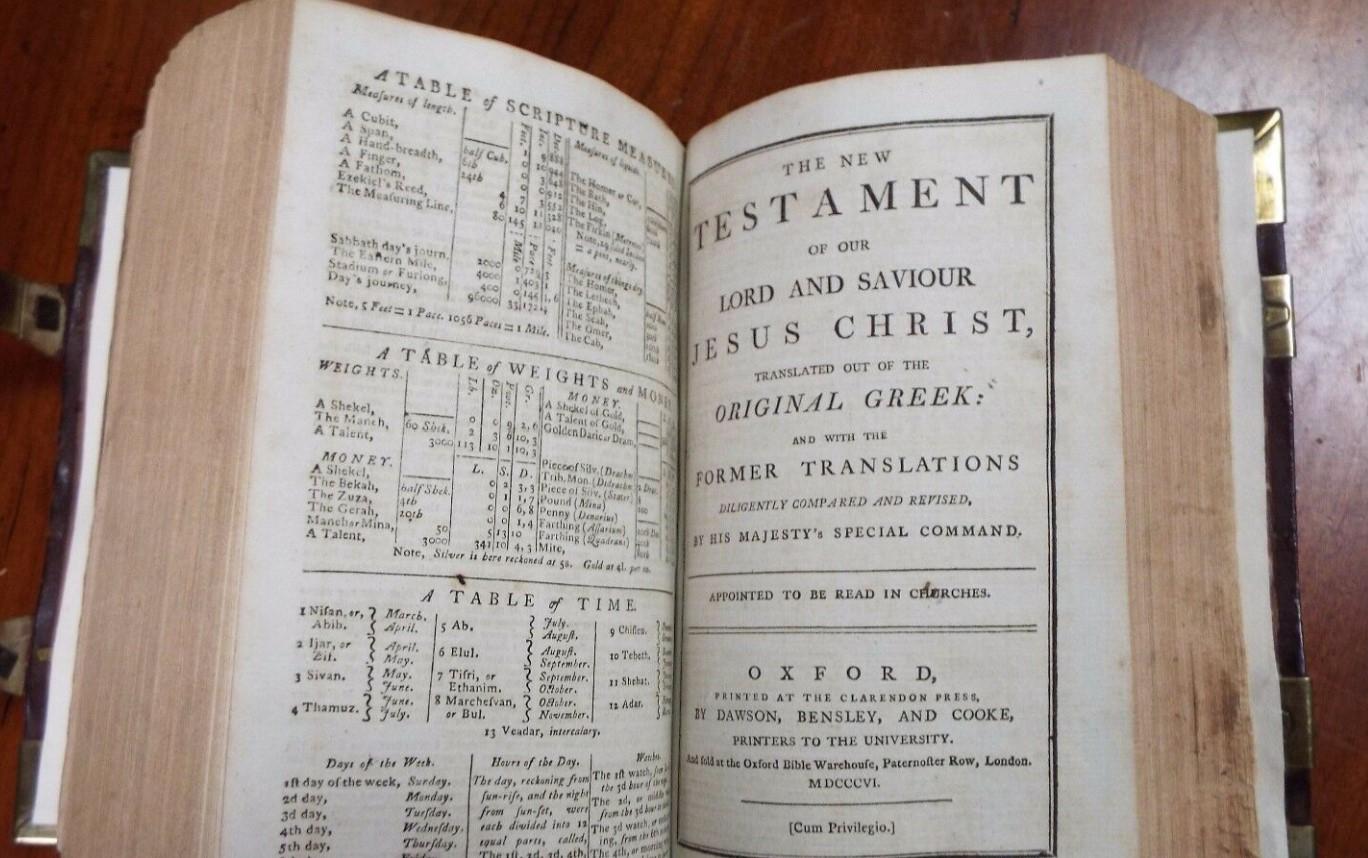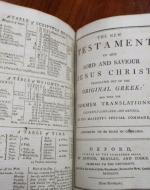Created by Hannah Stoughton on Tue, 10/08/2024 - 19:25
Description:
Image: "1806 King James Bible at Cross and Crown Rare Books"
Almost all religions have physical manifestos of their Scriptures, with all denominations of Christianity following the Holy Bible. For Anglicans like Jane Austen, the version of the Holy Bible that would have been used was the King James Version. The King James Version of the Holy Bible contains 80 books, with 39 being in the Old Testament, 27 in the New Testament, and 14 apocryphal writings.
Along with the changes of monarchs, and therefore religious belief, the Holy Scripture of England changed a multitude of times leading up to the King James Version. According to Houston Christian University's Bible Museum Exhibit, the earliest translation of the New Testament from Greek and Hebrew into English was completed by William Tyndale, a linguist. Originally, English translations of the New Testament were forbidden in England, so Tyndale completed his work in exile. He eventually smuggled copies of the New Testament into England before being caught and convicted of heresy.
The effect of Tyndale's translation is inexplicable. The English folk were now made aware of an entirely new set of Biblical stories and beliefs. They then worked to print a fully completed version of the Bible, which was accomplished in 1535 by Miles Coverdale. Coverdale added some more New Testament translations, while a friend of Tyndale, John Rogers, published his own version of the Bible under the pseudonym Thomas Matthews. It was not until 1539 that Henry VIII approved a Bible for public use in churches, making it the first Bible approved by a British monarch.
In between the Matthews Bible and the King James Bible, two lesser known Bibles were published. The Geneva Bible, which has originally been commissioned by Queen Mary I and finished during Queen Elizabeth I's reign, was published in 1560, and the Bishops' Bible was published in 1572 ("History of the English Bible," Houston Christian University).
In 1611, The King James Version of the Bible was officially printed after a nearly a century of work from previous translators. King James commissioned this Bible to be mass printed, allowing for lower class individuals to purchase the Bibles for private use within their households. The ability to access Holy Scripture became a critical founding component in Anglicanism, as it is viewed as the word of God and is therefore His connection to His people, and without its history, it would not have allowed families like the Austens to prosper in religious disciplines.
Though Austen's family was of the gentry class, the only reason her family life was sustained was due to the accessibility of faith and the Holy Scriptures of Anglicanism being widespread. The allowance of individuals into the churches in which George Austen, Jane's father, was a rectory gave the Austen family their social class. Without the Bible, Anglicanism would most likely not have been widespread, changing the course of England's religious trajectory.
Works Referenced
“Church of England ‑ Anglican Church.” History.Com, A&E Television Networks, www.history.com/topics/european-history/church-of-england. Accessed 8 Oct. 2024.
Cox, Brenda S. Fashionable Goodness: Christianity in Jane Austen’s England. Topaz Cross Books, 2022.
“History of the English Bible.” Houston Christian University, 1 Dec. 2015, hc.edu/museums/dunham-bible-museum/tour-of-the-museum/english-bible/.
“King James Bible 1806.” Good Hardcover | Cross and Crown Rare Books, www.abebooks.com/1806-King-James-Personal-Bible-Thomas/30852996245/bd. Accessed 8 Oct. 2024.


